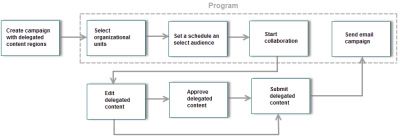Distributed Content Collaboration - Overview
Important: This feature is available only if Distributed Content Collaboration is enabled for your account.
Distributed Content Collaboration gives your distributed teams the ability to collaborate on email message content. For example, USA office wants to run local marketing campaign in which San Bruno, San Jose, and New York local marketers can contribute market-specific content to the email campaign for use by their respective markets.
How Distributed Content Collaboration works
The following illustration shows the workflow for a distributed campaign.
As shown in the illustration, launching distributed campaigns comprises the following steps:
- First, the regional manager:
- Creates a campaign with collaboration regions.
- In Program, selects the organizational units, audience, schedule, and starts the collaboration process.
- After the collaboration process starts, authorized users in the assigned organizational units receive an email notification and the assigned tasks appear in their task lists. Users then customize, approve (if required) and submit the content.
- After the content is submitted, Program launches the campaign as scheduled.
Key Concepts
Collaboration workflow
The process of submitting and approving delegated content.
Distributed campaign
A shared campaign to which users from different organizational units can contribute.
Collaboration region
Content region that users from different organizational units can edit.
Task
A delegated activity that a user needs to perform, such as submitting or approving content.
Organizational Unit
A single unit in your company’s organizational hierarchy, for example a sub-division, region, store, or brand.
Functional Access Control
Defines a user's role within Oracle Responsys. Functional access is controlled by the user's roles. For descriptions of each role, see Role Descriptions and Access Rights.
Organizational Access Control
Defines a user's organization within Oracle Responsys. For example, a user belonging to the West Coast organization can see campaigns assigned to the west coast, not campaigns assigned to his colleagues on the east coast.
Targeting by Organization
Provides the ability to target specific organizations based on the recipient's organization assignment without changing your filter definitions. For example, if your scheduled filter is set up for loyal customers, and you select the Bay Area organization through Targeting by Organization, only loyal customers in the Bay Area will be selected. Targeting by Organization applies only for the Scheduled Filter and Get Audience activity in Program, and in email campaigns. Audience access is controlled by the Audience Scoping Code.
Get started
Before you begin using content collaboration, your organization must do the following:
- The Account Administrator must create the organizational unit hierarchy and assign users to those organizational units.
- The Account Administrator must assign appropriate roles to users.
- The Account Administrator must define a collaboration event.
- The collaboration event communicates to Program that the collaboration process is complete.
- If multiple organizational units share one profile list but need access only to parts of it, the Data Director must specify the recipients to which an organization unit can market. Learn more about roles related to distributed content collaboration.
